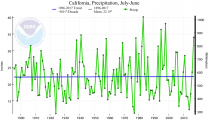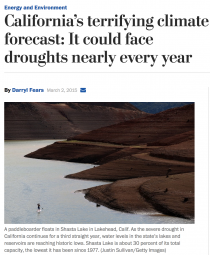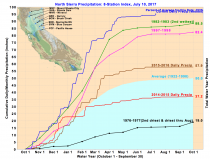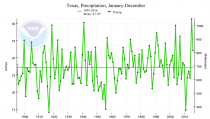Joseph D’Aleo, CCM, AMS Fellow
California precipitation is tied to the state of the Pacific Ocean (both ENSO where the El Ninos which are usually wet and La Ninas which are usually dry and the longer term Pacific Decadal Oscillation which influences the strength and frequency of El Nino and La Nina). It is highly variable but the long-term trend is a meaningless +0.01"/decade or +0.1” per century. That however does not stop climate scientists trolling for dollars or media environmental reporters from making it into a scare story.
Back just over a year ago in 2015 at the end of the two year drought, in the Washington Post, Darryl Fears had these headlines with many universities predicting future heat and drought and raising the possibility that is had already started!
The reporter actually did a lot of research into university research. Little did he know it all is nonsense.
-----
But then came the 2016/17 wet season which in places had the all-time record precipitation and snowfall (over 200% of normal).
And the result:
Climate scientists predict wet future for California
“What I am arguing is El Nino-like years are going to become more the norm in California,” said researcher Robert Allen.
UPI By Brooks Hays | July 6, 2017 at 3:50 PM
Heavy rain coupled with severe erosion caused the winter 2017 damaging of the Oroville Dam in northern California. New climate models run by scientists at the University of California, Riverside project that the northern part of California could experience increased rainfall through 2100.
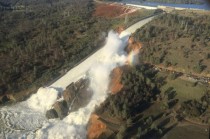
Heavy rain coupled with severe erosion caused the winter 2017 damaging of the Oroville Dam in northern California. New climate models run by scientists at the University of California, Riverside project that the northern part of California could experience increased rainfall through 2100. File Photo by EPA/California Department of Water Resources
July 6 (UPI)—Climate scientists now expect California to experience more rain in the coming decades, contrary to the predictions of previous climate models.
Most scientists agree that California, like most places, will get warmer through the end of the century. And until now, most agreed California would get drier. New research out of the University of California, Riverside, however, suggests otherwise.
The new models predict the state will enjoy a 12 percent increase in precipitation totals through 2100.
Both central and northern California will get wetter, according to the models, while Southern California will experience slightly less precipitation through the end of the century. Most of the increase in precipitation will be during the winter months.
“Most previous research emphasized uncertainty with regards to future precipitation levels in California, but the overall thought was California would become drier with continued climate change,” Robert Allen, an associate professor at UC Riverside, said in a news release. “We found the opposite, which is quite surprising.”
Weather variability makes it difficult to project how climate change will affect rain and snow totals. Predicting future precipitation totals in California is further complicated by the fact that the northern half of the state is expected to get wetter while the southern half is predicted to get drier.
But predictive climate and weather models are growing more sophisticated, allowing scientists to quiet the noise of yearly variability and focus on longterm patterns.
The new research—detailed in the journal Nature Communications—suggest increasing surface temperatures in the tropical eastern Pacific Ocean, lying to the 2,500 miles east, will encourage a local trade wind delivering a larger number of storm systems to the California coast.
“Essentially, this mechanism is similar to what we in California expect during an El Nino year,” Allen said. “Ultimately, what I am arguing is El Nino-like years are going to become more the norm in California.”
In other words, California’s future is likely to look more like the past two years, during which the state enjoyed record rainfall totals.
-----------
This is a little like Texas where the drought of 2011-2013 was supposed to be the start of a permadrought...but then came the flooding. Note the multi-year (7) more serious drought in the 1950s - both a reflection of the 60 year multidecadal ocean cycle?
The long term trend was flat at the time of the drought early this decade, now it slightly up since 1895.



